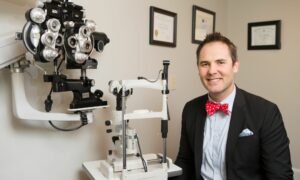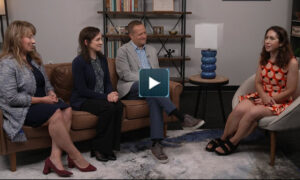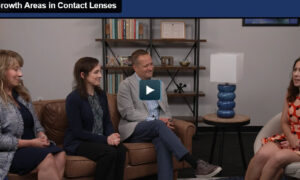Joseph S. Madrak, OD
SYNOPSIS
Patients over 40 love their contact lenses, but presbyopia presents visual challenges. Multifocal designs can keep these patients in their contacts and in your practice long-term.
ACTION POINTS
RECOGNIZE REVENUE-GENERATOR. As little as 250 multifocal patients can generate $50,000 annually.
SET PATIENT EXPECTATIONS. Let patients know they will sacrifice some distance vision to be free of reading glasses.
USE LIFESTYLE QUESTIONNAIRE. Knowing a patient’s work and hobbies lets you know what they need to be able to do in their multifocal contacts.
My patients love their contact lenses for convenience, lifestyle and providing excellent visual acuity. The advantage of visual clarity becomes a challenge when these patients reach their 40’s and experience the onset of presbyopia. Suddenly their spectacle-free world is invaded by reading glasses. For many of my patients, multifocal contact lenses provide a solution that allows them to continue to enjoy freedom from everyday spectacle wear.
Multifocal Lens Advanced Design
DEFINITIVE MULTIFOCAL from ABB OPTICAL GROUP is a patented contact lens designed with central near zone and unique addition, comprising concentric zones which accommodate changes in lighting, near, intermediate and distance vision.
LENS DESIGN
• The base curve geometry is made up of a spherical optic zone and an aspheric periphery
• Unique aspheric front curve has multi-optic zones
The DEFINITIVE MULTIFOCAL is manufactured from a new generation of silicone hydrogel material that increases ocular health. This lens is produced utilizing advanced C.N.C. diamond turning machines for greater accuracy and repeatability.
For more information about the DEFINITIVE Multifocal, e-mail specialtycontactlenses@abboptical.com
Recognize Practice-Building Capacity
My practice has around 2,000 contact lens-wearing patients. Of that number, about 250 are in multifocal contacts. My multifocal patients generate $50,000 annually. These revenues stem from the fitting fees, which are higher for multifocal patients than for those in single-vision contacts, and from the sale of the contacts. We charge an umbrella fee, so patients are free to return as often as needed to perfect their prescription, which is more challenging than it is to perfect prescriptions for single-vision contacts. Multifocal patients typically require an extra office visit with 10 minutes of added chair time per visit compared to single-vision contact lens patients.
Set Patient Expectations
Presbyopic patients need to understand that there will be a visual sacrifice in exchange for living glasses-free. For myopes, in particular, I tell patients we need to “rob Peter to pay Paul,” meaning we’re going to have to take away a little distance vision for them to see adequately up close. We want to accomplish our goal of freeing them from the need for reading glasses and making their vision functional most of the time.
Have Staff Sit In On Conversation with Patients
Like any prescription, your staff has to reinforce your multifocal message. You can educate staff by having them sit in on your conversations with multifocal patients. It is important that they reiterate the point that a visual compromise is often needed to do away with reading glasses. In addition, I train my staff to only measure multifocal patients’ eyes together when they have contact lenses on to give patients a realistic measure of their visual acuity. I also have staff remind patients that they will need time to adjust to their multifocal contacts. We let patients know their vision may not feel right during their first days in multifocals, but that if they give their eyes time to adjust, they may be impressed with the results.
Explain: Not all Multifocals Are Equal
I explain that multifocal contact lenses come in a variety of designs and technologies that can suit each individual patient differently. Each design may interact differently with the brain and eyes, and the material may interact differently with the ocular surface. For example, the new DEFINITIVE multifocal lens from ABB OPTICAL GROUP combines a great multifocal design with excellent optics and a new generation of silicone hydrogel material that helps keep the ocular surface comfortable and healthy all day.
Joseph S. Madrak, OD
Optometry school: SUNY College of Optometry, class of 2005
Practice: Dr. Joseph S. Madrak, OD LLC, founded 2010, practicing in Hartford and Prospect, Conn.
Practice niche: Specialty contact lens fittings, treatment of eye disease, low vision and comprehensive eyecare.
Doctors: 3
Support staff: 9
Patients: 12,000
Comprehensive exams: 2,500 performed yearly per doctor.
Each patient’s visual processing, ergonomics and lifestyle is different. Certain designs work better for certain patients. Sometimes it’s trial and error. I use simple language to illustrate the difference between multifocal lenses: “Not every shoe or pair of pants fits the same. They may all be the same size, but some will feel more comfortable than others. Eventually you find the right fit.” It’s similar with multifocal contacts–eventually you find the right lenses with great vision and comfort all day.
Use Lifestyle Questionnaire to Help Hone Prescription
The lifestyle questionnaire we use for all patients is particularly helpful in perfecting multifocal prescriptions. The questionnaire asks about work and hobbies, so we know how much the patient is reliant on detailed, up-close vision versus the need for sharp distance vision. For example, one patient may love to do embroidery as a hobby and use a computer all day at work, therefore having high near demands while another patient may be on the road driving a lot for work requiring superb distance vision.
Have Multifocal Contact Lens Conversation with All Progressive Spectacle-Wearers
I ask all progressive eyeglasses patients if they have heard of multifocal contact lenses, pointing out from their lifestyle form where in their lives I think they could benefit from contacts that allow them to see both near and far. Having this initial conversation usually leads to at least a fitting and a trial of multifocal contacts. Not every patient will be happy in a multifocal lens, but those who are will be thrilled about what you did for them, and will tell others. Set clear goals and keep expectations realistic before the fitting. Remain persistent when trouble shooting the fit with patients, reminding them that your ultimate priority is making them happy.
Related ROB Articles
Make Specialty Contact Lenses a Profit-Maker with the Right Manufacturer
Multifocal CLs: Aging Population Makes This a Practice-Builder
Develop a Specialty in Multifocal Contact Lenses
Joseph S. Madrak, OD, is the owner of Joseph S. Madrak, OD LLC and practices in Hartford and Prospect, Conn.



























